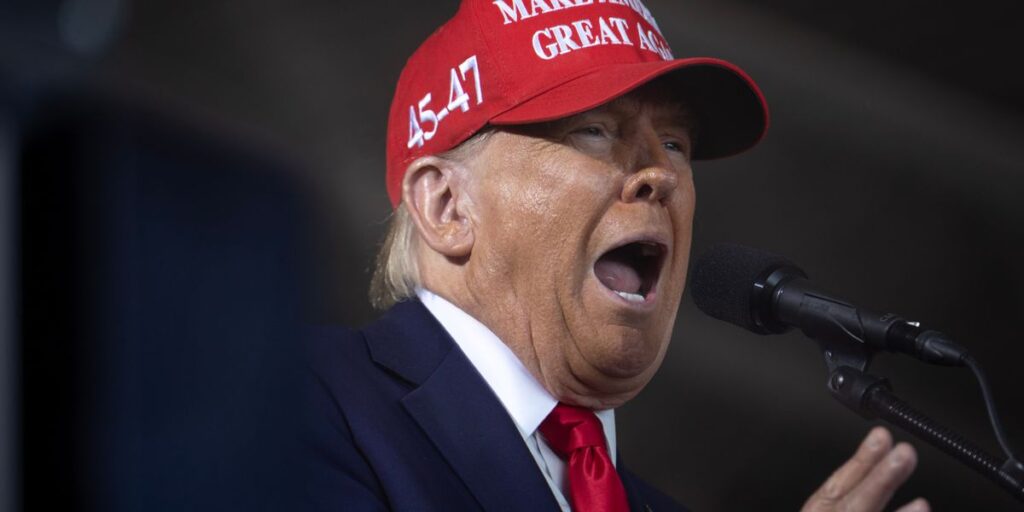Donald Trump’s ongoing presidential campaign is notably focused on rallying in predominantly Democratic states like California, New York, and Colorado, regions where his chances of winning are significantly low. With less than a month until Election Day, Trump’s decision to allocate time and resources to these strongholds raises questions about the efficacy of his strategy. Instead of concentrating efforts on critical battleground states that hold a better chance for victory against Democratic nominee Kamala Harris, Trump’s campaign believes that these rallies serve as a platform to criticize immigration and border security issues, placing the blame on Harris and fellow Democrats. This tactical choice reflects a long-standing narrative Trump has utilized, which started during his initial ascent to the presidential race in 2016.
At a rally in Coachella, California, Trump’s campaign aims to frame the current state of California as a dire situation under Democratic leadership, which he claims is detrimental to the daily lives of Americans. Noticeably, Kamala Harris’s deep ties to California—as a senator and former attorney general—put her right in the line of Trump’s criticism. The messaging surrounding this particular rally indicates that the campaign intends to highlight Harris’s affiliation with local Democrats such as Governor Tim Walz, leading to a portrayal of California’s challenges as a direct result of Democratic governance. Trump’s campaign press release epitomizes this blame-instilling rhetoric, asserting that the so-called “California Dream” has devolved into a “nightmare” due to Democratic policies.
Despite the nearly guaranteed defeat in these deep-blue states, some Republican strategists maintain that Trump’s rallies could importantly resonate with Latino voters nationwide, who have shown signs of shifting towards the Republican Party. This unexpected trend in Latino voting patterns, which is at its lowest in terms of Democratic advantage in years, suggests that a successful engagement in such communities could be beneficial for Republicans. However, many question the efficacy of campaigning in California rather than focusing on nearby Arizona, a swing state where Trump is virtually tied with Harris, as a potentially smarter allocation of resources to sway critical voters.
In addition to the rally in Coachella, Trump has planned an event at Madison Square Garden in New York City less than two weeks before the election. The choice of midtown Manhattan as his rally location has been criticized as puzzling since it is a firmly Democratic region. Observers suggest that Trump could have gained more traction by visiting areas with more Republican representation, such as Long Island. This decision to stage a rally in a location unlikely to deliver any electoral benefits is seen as a curious move, raising doubts about whether it serves a strategic purpose with the countdown to the election intensifying.
Moreover, Trump’s intentions in Aurora, Colorado—highlighted during recent debates with claims about immigrant gangs—have drawn local rebukes and further criticism. His narrative regarding local crime linked to immigration has not only been dismissed by officials but also leads many analysts to speculate whether his rhetoric aligns with productive campaigning. Doug Heye, a former RNC communications director, expresses that Trump’s political focus on areas with little chance of winning detracts from more feasible targets where he could motivate voters and potentially secure victories in crucial swing states.
Conversely, Vice President Kamala Harris continues her campaign in critical battleground states like Arizona and Pennsylvania, reinforcing the strategy to engage where votes are truly needed. Harris’s team critiques Trump’s unusual campaign approach, suggesting that it reflects a self-serving agenda rather than a genuine desire to foster change for the American populace. This juxtaposition between Trump’s campaign involvement in non-competitive strongholds and Harris’s strategic presence in swing states encapsulates how the weeks leading up to the presidential election will likely unfold, underscoring the contrasting tactics at play as both parties seek to galvanize their respective bases and sway undecided voters.

